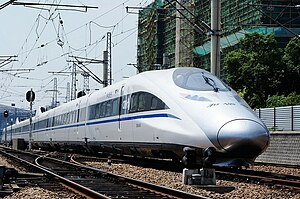
Back Çində sürətli qatar Azerbaijani চীনের দ্রুতগতির রেল Bengali/Bangla Alta velocidad ferroviaria en China Spanish Kiinan suurnopeusjunaradat Finnish Grande vitesse ferroviaire en Chine French Kína nagysebességű vasúti közlekedése Hungarian Kereta kecepatan tinggi di Tiongkok ID Ferrovia ad alta velocità in Cina Italian 中華人民共和国の高速鉄道 Japanese 중화인민공화국의 고속철도 Korean
The high-speed rail (HSR) network in the People's Republic of China (PRC) is the world's longest and most extensively used – with a total length of 45,000 kilometres (28,000 mi) by the end of 2023.[1][2][3] The HSR network encompasses newly built rail lines with a design speed of 200–380 km/h (120–240 mph).[4] China's HSR accounts for two-thirds of the world's total high-speed railway networks.[5][6] Almost all HSR trains, track and service are owned and operated by the China Railway Corporation under the brand China Railway High-speed (CRH).
High-speed rail developed rapidly in China since the mid-2000s. CRH was introduced in April 2007 and the Beijing-Tianjin intercity rail, which opened in August 2008, was the first passenger dedicated HSR line. Currently, the HSR extends to all provincial-level administrative divisions and Hong Kong SAR with the exception of Macau SAR.[note 1][note 2][note 3]
Notable HSR lines in China include the Beijing–Kunming high-speed railway which at 2,760 km (1,710 mi) is the world's longest HSR line in operation, and the Beijing–Shanghai high-speed railway with the world's fastest operating conventional train services. The Shanghai Maglev is the world's first high-speed commercial magnetic levitation ("maglev") line that reach a top speed of 430 km/h (267 mph).[8]
Economics of the high-speed rail has been a topic of discussion.[9][10] A 2019 study produced by TransFORM, a knowledge platform developed by the World Bank and China’s Ministry of Transport, estimated the annual rate of economic return of China's high-speed rail network in 2015, to be at 8 percent, which is well above the opportunity cost of capital in China for major long term infrastructure investments. The study also noted a range of benefits which included shortened travel times, improved safety and better facilitation of tourism, labor and mobility, as well as reducing highway congestion, accidents and greenhouse emissions as some automobile travellers switch from car use to rail.[11][12] A 2020 study by Paulson Institute has estimated the net benefit of the high-speed rail system to be approximately $378 billion, with an annual return on investment of 6.5%.[13]
- ^ "Length of Beijing-HK rail network same as Equator". www.thestar.com.my. Retrieved 2022-01-01.
- ^ Ma, Yujia (马玉佳). "New high-speed trains on drawing board- China.org.cn". www.china.org.cn. Retrieved 2017-11-13.
- ^ Preston, Robert (3 January 2023). "China opens 4100km of new railway". International Railway Journal.
- ^ Lawrence, Martha; Bullock, Richard; Liu, Ziming (2019). China's High-Speed Rail Development. Washington, DC: The World Bank. p. 12. ISBN 978-1-4648-1425-9.
- ^ "Full speed ahead for China's high-speed rail network in 2019". South China Morning Post. 2019-01-03. Retrieved 2019-06-23.
- ^ "China builds the world's longest high-speed rail as a rail stalls in the U.S." finance.yahoo.com. 21 February 2019. Retrieved 2019-06-23.
- ^ "China-Tibet bullet trains to commence operations before July". Railway Technology. 8 March 2021.
- ^ "World's Longest Fast Train Line Opens in China". Associated Press. Archived from the original on 29 December 2012. Retrieved 26 December 2012.
- ^ "China's High-Speed Rail, the world's longest high-speed railway network, is now losing $24 million per day with a reported debt of $1.8 trillion". 13 November 2021.
- ^ "China Railway's debt nears $900bn under expansion push".
- ^ Gerald Ollivier, Richard Bullock, Ying Jin and Nanyan Zhou, "High-Speed Railways in China: A Look at Traffic" World Bank China Transport Topics No. 11 December 2014, accessed 2017-07-17
- ^ "China's Experience with High Speed Rail Offers Lessons for Other Countries". World Bank. Retrieved 2022-09-20.
- ^ "Is the HSR worth it?". MacroPolo. Retrieved 2021-01-24.
we estimate that the HSR network confers a net benefit of $378 billion to the Chinese economy and has an annual ROI of 6.5%.
Cite error: There are <ref group=note> tags on this page, but the references will not show without a {{reflist|group=note}} template (see the help page).
© MMXXIII Rich X Search. We shall prevail. All rights reserved. Rich X Search




